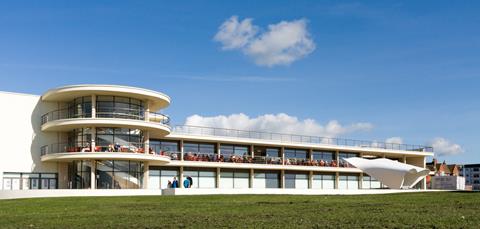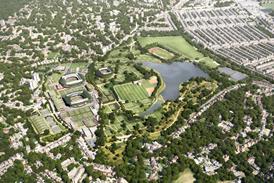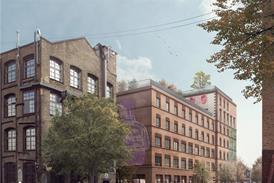Cross-disciplinary thinking in the public sector is key to addressing climate change, social justice, and urban development, writes David Chambers

I am an architect with over 20 years of experience, specialising in designing civic, cultural, and community projects across various scales for private clients, institutions, and local authorities. I was a co-founding director at Aberrant Architecture. Our approach integrated storytelling and collaboration with communities and stakeholders to create award-winning public art projects, installations, interiors, and exhibition designs. Our practice was honoured to be the first architecture residents at the V&A Museum and has showcased work at the British Pavilion during the Venice Biennale and the DesignTO Festival in Toronto. We also co-launched The Gopher Hole, an experimental project space in London.
Alongside my practice, I have cultivated a parallel career in architectural education, teaching at Central Saint Martins and the University of Brighton. My work with Aberrant focused on celebrating people and place, albeit often temporarily. I have increasingly felt the desire to contribute to initiatives that have a lasting positive impact on communities, their lives, and their environments.
Long-term thinking is crucial to addressing major spatial challenges such as climate change, health inequalities, social justice, and the future of our towns and cities. These issues are too complex for any one discipline to tackle alone, which is why I believe the public sector is uniquely positioned to foster integrated thinking and cross-disciplinary collaboration.
My interest in the public sector as a powerful agent of change was sparked during my university studies on “Metabolism.” I was fascinated by how Japanese architects, artists, and designers, in partnership with an innovative bureaucracy and proactive state, turned the challenges of a post-war nation into a source of inspiration for planning and design. These interests coalesced in my book Wherever You Find People, which explored a large-scale state school infrastructure project in Brazil. This research underscored the profound impact that can be achieved by working within a system to drive meaningful change.

During my 12-month Public Practice placement at Rother District Council, I served as principal design officer within the Place and Climate Change Directorate, providing design leadership on major projects. This included the forthcoming transformation of the De La Warr Pavilion, led by Howarth Tompkins Architects, and developing new placemaking policies to shape the district’s emerging local plan. The combination of design work and strategic planning has been immensely rewarding.
One key observation during my time at the council was that design was initially perceived as a barrier rather than an asset at the planning policy level. An early ‘Doughnut’ concept diagram for the new Rother local plan illustrated this perspective, grouping heritage and design together as constraints on development. Recognising the need to shift this conception of design – not as a problem to solve, but as a powerful solution – I advocated for a fresh perspective. Fortunately, design has now been decoupled from heritage and is no longer viewed as a constraint. We successfully positioned design and placemaking at the heart of the emerging Rother Local Plan.
My first year in the public sector has profoundly shifted my perspective on the built environment. Previously, I believed that the primary challenge in the UK was building new homes, but I have come to realise that the lack of infrastructure to support these developments is arguably just as critical. However, it is encouraging to see the emergence of organisations like Active Travel England, which promotes walkable and bike-friendly communities, as well as new biodiversity legislation and increased support for sustainable urban drainage systems (SuDS). With the recent change in government, I am excited to contribute to a new generation of settlements designed to stack the benefits of active travel and green infrastructure, creating places where people truly want to live.
As a Public Practice Associate, it has been incredibly rewarding to be part of a community of like-minded practitioners
During my placement, I had the opportunity to develop the “Live Well Locally” policy, aimed at creating healthy, sustainable, and inclusive communities. Our vision includes connected, compact towns in Bexhill, Battle, and Rye, as well as vibrant village clusters within Rother’s rural areas. These communities will feature buildings with character and design that respect local history and identity, fostering a strong sense of belonging and shared experience. Drawing on national guidance, we have crafted tailored policies to ensure that future Rother residents can easily access essential facilities, services, nature, and parks by walking, cycling, and public transport. In support, I also produced an evidence-based document on density.
At Rother, I have thoroughly enjoyed collaborating as part of a larger team and engaging with colleagues across various services, including planning policy, development management, and special projects. The perks of being part of a team have allowed me to enjoy the social opportunities, which, along with an array of events, have, to my own surprise, seen me come out of retirement and grace the five-a-side pitch.
The associate programme’s learning and development course was an invaluable resource, offering a fast-track introduction to working in the public sector. As a Public Practice associate, it has been incredibly rewarding to be part of a community of like-minded practitioners, distributed across the country. It has been immensely beneficial to share this transition into a new career with a group of fellow professionals, allowing us to help and learn from each other while also forming new friendships.
Looking forward, I am now permanently employed as the design team leader at Rother. I am committed to continuing to elevate the profile of design and further position placemaking as a key priority within both the district’s local plan and the council’s broader strategy. My role involves the scrutiny of major schemes and has expanded into planning policy. I am now a member of the High Weald national landscape officer steering group and serve as the Combe Valley Countryside Park CIC liaison officer. Currently, I am working on an ambitious vision for Bexhill North, aligning with the healthy placemaking aspirations of “Live Well Locally.” This effort will culminate in an area-based masterplan, crafted in collaboration with the local community.
Postscript
David Chambers was a Public Practice associate, and is now design team leader at Rother District Council
You can learn more about the inner workings of the public sector, and the Public Practice associate programme here
















No comments yet